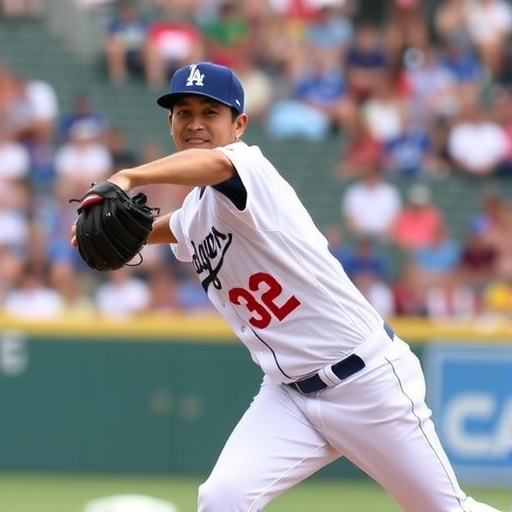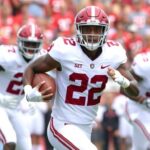Yoshinobu Yamamoto Secures Second Straight Complete Game as Dodgers Crush Opponents in MLB Thriller
In a display of pitching mastery that has fans buzzing across the MLB landscape, Yoshinobu Yamamoto tossed his second consecutive complete game, propelling the Los Angeles Dodgers to a resounding 5-1 victory over the San Francisco Giants at Dodger Stadium. The 25-year-old Japanese sensation struck out 10 batters over nine innings, allowing just four hits and one earned run, further cementing his role as the cornerstone of the Dodgers‘ rotation in this high-stakes baseball season.
- Yamoto’s Mound Magic: Breaking Down the Second Complete Game Gem
- Dodgers’ Lineup Erupts: Offensive Highlights Fuel the Rout
- Rotation Reinforcements: Yamamoto Solidifies Dodgers’ MLB Pitching Core
- NL West Implications: Dodgers Pull Away in Tight Division Race
- Future Horizons: Yamamoto’s Streak Signals Dodgers’ Playoff Dominance
Yamamoto’s back-to-back complete games mark a rare feat in modern MLB, where starters rarely go the distance due to pitch counts and bullpen strategies. His performance not only highlighted his endurance but also sparked celebrations among Dodgers supporters, who see this as a sign of the team’s deepening dominance in the National League West. With the win, the Dodgers improved to 78-52, extending their lead in the division to six games.
Yamoto’s Mound Magic: Breaking Down the Second Complete Game Gem
Yoshinobu Yamamoto’s latest outing was a clinic in control and deception, showcasing why the Dodgers invested over $325 million in the right-hander during the offseason. Facing a Giants lineup that includes power threats like LaMonte Wade Jr. and Matt Chapman, Yamamoto mixed his signature splitter with a lively fastball clocking up to 97 mph. He walked just one batter, inducing 18 groundouts and flyouts that kept the Dodger Stadium crowd on the edge of their seats.
Statistics from the game paint a picture of utter dominance: Yamamoto threw 102 pitches, 72 for strikes, and generated a whopping 25 swings-and-misses. This complete game followed his previous masterpiece against the Colorado Rockies, where he fanned nine and allowed only two runs. “Yamamoto’s stuff is electric,” said Dodgers manager Dave Roberts post-game. “He’s not just pitching; he’s commanding the game like a veteran who’s been in the majors for a decade.”
In the context of MLB history, complete games have become an endangered species. Only 19 were thrown league-wide last season, making Yamamoto’s streak a throwback to the era of aces like Sandy Koufax. For the Dodgers, this means fewer innings for a taxed bullpen, which has been stretched thin by injuries to Walker Buehler and others. Yamamoto’s efficiency—averaging under 11 pitches per inning—allows the team to preserve arms for the playoff push.
Delving deeper into his arsenal, Yamamoto’s splitter proved lethal in the late innings. In the seventh, he used it to freeze Thairo Estrada for a crucial strikeout with runners on base, escaping a potential rally. Baseball analysts on ESPN noted that his pitch mix baffles hitters, with opponents batting just .198 against him this season. This performance elevates Yamamoto’s ERA to a sparkling 2.45 over 28 starts, positioning him as a Cy Young contender.
Dodgers’ Lineup Erupts: Offensive Highlights Fuel the Rout
While Yamamoto stole the show on the mound, the Dodgers’ offense provided ample support, scoring all five runs in the first four innings to give their ace a comfortable cushion. Mookie Betts led off with a double, setting the tone, and was driven in by Freddie Freeman’s RBI single. The second inning saw Shohei Ohtani crush a two-run homer to left field, his 42nd of the year, extending the lead to 3-0.
The Dodgers’ bats didn’t let up. In the fourth, Will Smith added a solo shot, his 18th, while Teoscar Hernández contributed with a sacrifice fly. The team’s .278 collective batting average in the game underscored their balanced attack, with eight hits scattered across the lineup. Against Giants starter Logan Webb, who entered with a sub-3.00 ERA, the Dodgers exploited mistakes, drawing four walks and capitalizing on defensive miscues.
Roberts praised the offensive cohesion: “When our starters go deep like Yamamoto, it takes the pressure off the hitters. Tonight, we swung early and often, setting the table for a big win.” This victory is part of a seven-game winning streak for the Dodgers, during which they’ve outscored opponents 42-15. Key contributors like Ohtani, now leading the NL in home runs and RBIs, have been pivotal, but Yamamoto’s complete game allowed the bullpen—featuring Evan Phillips and Blake Treinen—to rest entirely.
Looking at broader trends, the Dodgers’ home dominance is evident: They’ve won 45 of 58 games at Dodger Stadium, with an average margin of victory exceeding three runs. This offensive firepower, combined with Yamamoto’s shutdown pitching, makes Los Angeles the team to beat in October baseball.
Rotation Reinforcements: Yamamoto Solidifies Dodgers’ MLB Pitching Core
Yoshinobu Yamamoto’s emergence as a complete game artist has transformed the Dodgers’ rotation from solid to elite. Signed to a 12-year, $325 million deal after a storied career in Japan’s NPB—where he won three consecutive MVP awards and struck out over 1,000 batters—Yamamoto has adapted seamlessly to MLB’s rigors. His transition hasn’t been without hurdles; early-season shoulder inflammation sidelined him for two months, but since returning in June, he’s 10-2 with a 1.98 ERA.
In the Dodgers’ rotation, Yamamoto slots in behind Tyler Glasnow and Landon Knack, creating a formidable top three. Glasnow leads the NL in strikeouts with 198, but Yamamoto’s completeness adds depth. “Having Yamamoto go nine innings twice in a row is huge for our workload management,” Roberts explained. “It keeps our relievers fresh for the stretch run.”
Comparatively, MLB’s complete game leaders this year include Tarik Skubal with three, but Yamamoto’s streak is unique among newcomers. His NPB background, where complete games are more common, has given him an edge in stamina. Teammate Clayton Kershaw, recovering from surgery, lauded him: “Yamamoto’s work ethic is unmatched. He’s the real deal for Dodgers baseball.”
The financial commitment paid off immediately, with Yamamoto’s WAR (Wins Above Replacement) at 4.2, ranking him among the top 10 starters. As the trade deadline approaches, the Dodgers’ front office, led by Andrew Friedman, can focus on position players rather than pitching, knowing Yamamoto anchors the staff.
NL West Implications: Dodgers Pull Away in Tight Division Race
The Dodgers’ win over the rival Giants not only boosted their record but widened the gap in the NL West standings. San Diego sits at 72-58, six games back, while the Giants fell to 68-62, now 10 games out. Yamamoto’s complete game was the fourth shutout or near-shutout in the last 10 Dodgers starts, illustrating their pitching edge.
Baseball pundits are taking notice. On MLB Network, analyst Trevor Plouffe said, “Yamamoto is making the Dodgers’ rotation untouchable. This team is built for a deep playoff run.” The Giants, struggling with a 4.12 team ERA, couldn’t mount a comeback, managing only a solo run in the third on a Wade Jr. double.
Historically, Dodgers-Giants matchups are marquee events, with 248 meetings since 1993. This game added to the lore, as Yamamoto improved to 2-0 against San Francisco. For the Dodgers, maintaining this momentum is crucial; they’ve clinched a playoff spot but eye the division title for home-field advantage.
Fan reaction poured in on social media, with #YamamotoComplete trending nationwide. Attendance at Dodger Stadium hit 52,000, reflecting the excitement around this baseball powerhouse.
Future Horizons: Yamamoto’s Streak Signals Dodgers’ Playoff Dominance
As the regular season winds down with 32 games remaining, Yamamoto’s consecutive complete games signal a Dodgers team primed for postseason glory. His next start against the Padres could further solidify the division lead, potentially clinching it early. With Ohtani’s two-way brilliance and Freeman’s steady bat, the lineup complements Yamamoto’s pitching perfectly.
Looking ahead, the Dodgers face a schedule featuring series against the Phillies and Braves—tests that will gauge their mettle. Yamamoto’s health remains key; managing his workload post-streak will be Roberts’ challenge. Yet, with a rotation ERA of 3.45 (second in MLB), Los Angeles is favored to repeat as World Series champions.
Experts project Yamamoto for 15 wins and an All-Star nod, enhancing his marketability. For fans, this era of Dodgers baseball, powered by international stars like Yamamoto and Ohtani, promises thrills. As Roberts put it, “We’re just getting started.” The blueprint for success is clear: Pitching depth, offensive punch, and stars shining bright under the Dodger Stadium lights.
In the ever-evolving world of MLB, where analytics often prioritize efficiency over endurance, Yamamoto’s old-school approach is a refreshing reminder of baseball’s timeless appeal. His journey from Hiroshima to Hollywood continues to inspire, positioning the Dodgers not just as contenders, but as favorites to hoist the trophy in October.









